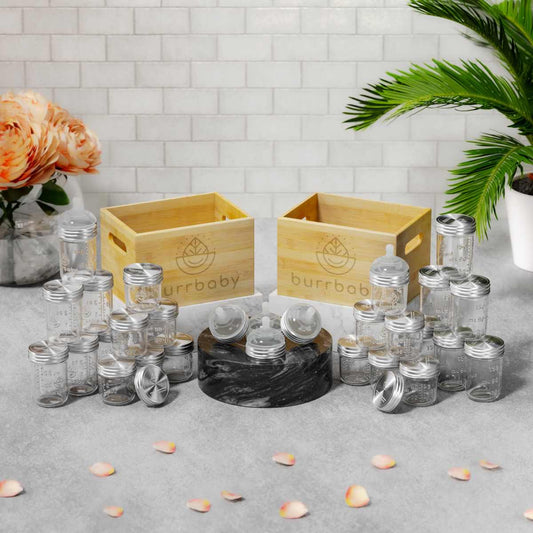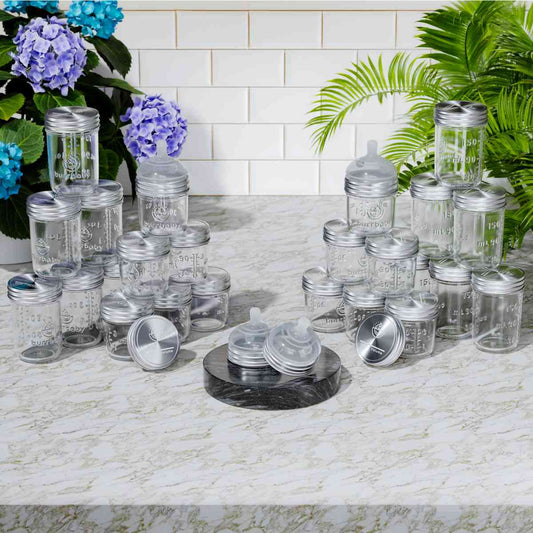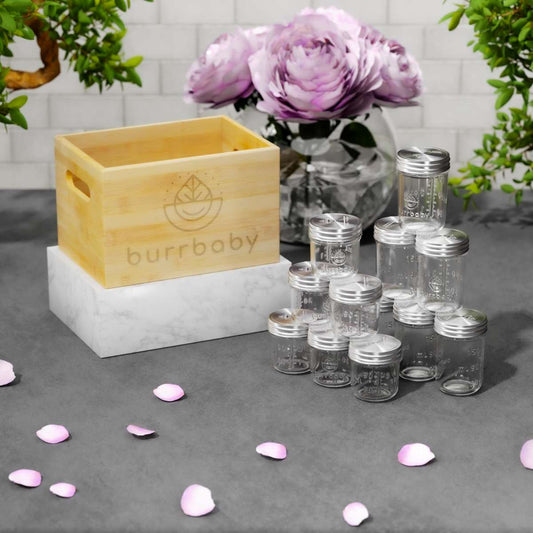Navigating the ins and outs of breastfeeding can sometimes feel like you're going through a maze with a blind fold on. When it comes to pumping, you want to ensure that every ounce of effort put into expressing your milk isn't wasted, and that it remains safe and nutritious for your baby.
So, let's talk about some tips for storing breast milk and how to keep it safe for your baby!
Article Overview
- Tip 1: Choose the Right Storage Container
- Tip 2: Label and Date Your Breast Milk Containers
- Tip 3: Know the Proper Storage Guidelines
- Tip 4: Use a "First In, First Out" System
- Tip 5: Maintain Proper Hygiene During Milk Expression and Storage
At Burrbaby, we're dedicated to being a part of a healthier world for your children. We hope to accomplish this through our zero-plastic glass breast milk storage containers and bottles. These completely non-toxic, sustainable choices protect your baby's health and our planet.
Tip 1: Choose the Right Storage Container
You go through all the work of pumping your liquid gold, but have you ever thought about the type of container you store it in? Most mothers default to plastic breast milk storage bags, but there are a few reasons you may want to think again. Glass is fast becoming a preferred choice by many parents.

Glass Containers vs. Plastic Containers
Research has shown that some plastics can leach chemicals and microplastics into stored breast milk milk, which could harm a baby's development and health later in life.
Glass, on the other hand, is a safer and more environmentally friendly option. It doesn't contain harmful chemicals and is easier to clean and sterilize.
There are actually quite a few benefits to glass that might be worth exploring.
Read more about the benefits of glass containers for breastmilk storage and feeding here.
The Benefits of Burrbaby Glass Containers
We built Burrbaby because we felt someone needed to create a breastmilk storage and feeding solution that prioritized your baby's safety and environmental responsibility. Our durable, zero-plastic glass breastmilk containers are a great choice for moms looking for a better way to store their breast milk.
Burrbaby products are also meant to make your switch to glass not just a health and eco-friendly choice, but a choice that once made, is actually more practical and convenient as well.
Tip 2: Label and Date Your Breast Milk Containers
The Importance of Tracking Freshness
You want to ensure your little one gets the freshest and most nutritious breast milk possible. To achieve this, you'll need to keep track of when you pumped your stored milk. Properly labeling and dating your breast milk containers will help you use the oldest milk first and avoid feeding your baby expired or spoiled milk.
At Burrbaby, we know the importance of proper labelling so we have our lids printed with fields to write date, time and volume.
Recommendations for Labeling and Dating
Choose a method that works for you
There are several ways to label and date your breast milk containers. We recommend an erasable marker or permanent marker. The permanent marker will last much longer, but requires some sort of nail polish remover or rubbing alcohol to get off.
Alternatively, you can use adhesive labels, masking tape, or even freezer-safe tape to label the containers. Choose a method that suits your needs and preferences, but ensure it can withstand fridge and freezer temperatures.
Include relevant information
When labeling your containers, the three most important pieces of information you need to include are the date, time, and volume of expression. If your baby is in daycare or under the care of someone else, consider adding your baby's name to avoid confusion.
Keep it legible and organized
Make sure to write clearly and legibly when labeling your breast milk containers. This will help ensure that you and others can easily read the information when it's time to use the milk. It's also very helpful to use a consistent labeling system to make identifying and organizing your stored milk easier.

Labeling and dating your breast milk containers is essential to creating a safe and efficient storage system for your breast milk milk. By following these recommendations, you can ensure that your baby receives the freshest and most nutritious breast milk while minimizing waste and making the most of your valuable storage space.
Remember storage solutions like Burrbaby's glass containers and bamboo boxes can further support a safe, organized breast milk storage system for you and your baby.
Read here for more information on safe refrigerator and freezer storage of breastmilk.
Tip 3: Know the Proper Storage Guidelines
Understanding the proper storage guidelines for breast milk is crucial to ensure your breast milk remains fresh and safe for your baby. Following the Centers for Disease Control and Prevention (CDC) recommendations give us a great place to start. According to the CDC, breast milk can be safely stored in the refrigerator for up to four days at a temperature of 40°F (4°C) or lower.
To maintain the quality of your breast milk, place it in the back of the fridge where the temperature is most consistent. Avoid storing it on the door or close to the front, as frequent opening and closing can cause temperature fluctuations. We like to keep our freezer a few degrees colder than normal, around 38 degrees F.
Guidelines for Freezer Storage
Your freezer is an excellent option for storing breast milk for extended periods. The CDC states that breast milk can last up to six months or even twelve months for standalone deep-freezers, depending on the freezer's temperature and other factors.
When freezing breast milk, leave some space at the top of the container as liquids expand when frozen, and you definitely don't want to come back to a container that has over-expanded. It's also a good idea to store the milk in small quantities (around 2-4 ounces according to Mayo) to reduce waste and make thawing more manageable.
Thawing and Warming Breast Milk Safely
Once you're ready to use the stored breast milk, it's important to thaw and warm it safely. The CDC recommends thawing breast milk in the refrigerator overnight, under running warm water, or in a container of warm water. Avoid using the microwave or very hot/boiling water as it can hurt your baby and damage the milk's nutrients
Ensure the milk is at body temperature or slightly warmer but never hot before feeding your baby. Some baby's even like it lukewarm or cool, it's really up to your baby. Swirl the container gently to mix the fat and milk evenly, then test the temperature by dropping a small amount on your wrist. Remember, breast milk should be consumed within 24 hours of thawing and never refrozen once thawed.
By following these guidelines, you can ensure that your precious breast milk remains safe and nutritious for your baby, giving them the best possible start.
Head here for more tips on safe breastmilk storage and signs of spoilage.
Tip 4: Use a "First In, First Out" System
The "First In, First Out" (FIFO) system is a tried-and-true organization method, especially for perishable items like breast milk. By adopting this approach, you'll ensure that the oldest milk is always used before the newer milk, reducing the risk of spoilage and maintaining the quality of the milk your baby consumes.
Implementing the FIFO System Effectively with Glass Containers
To effectively implement the FIFO system in your fridge and freezer, start by chronologically arranging your glass containers of breast milk, placing the oldest containers at the front and the newest ones at the back. This way, you'll naturally reach for the oldest milk first. In addition, labeling each container with the date of expression will help you keep track of their age.
Using Burrbaby's Bamboo Box for Organization
A bamboo box, such as the one provided by Burrbaby, offers numerous advantages for organizing breast milk storage. It supports the FIFO system by keeping all your storage containers easily organized. In addition, the bamboo box keeps your glass containers secure and tidy, preventing them from rolling around or getting lost in the back of your fridge or freezer.
In conclusion, adopting the FIFO system, with Burrbaby's glass containers and bamboo box, can help you maintain your baby's highest quality breast milk while promoting sustainability and organization in your storage routine.
Tip 5: Maintain Proper Hygiene During Milk Expression and Storage
Washing Hands and Sterilizing Equipment
To keep your baby safe, it's important to maintain a certain level of cleanliness throughout expression and storage of your breast milk. Before expressing breast milk, always wash your hands with soap and warm water for at least 20 seconds. This simple step helps minimize the risk of transferring germs to your breast milk.

Your breast pump is the first thing your breast milk touches after leaving your body, so keeping it clean and sterile is very important. The Centers for Disease Control (CDC) recommends washing all items with warm, soapy water and air drying on a clean surface. For added protection, you may also choose to sterilize the equipment by boiling, using a microwave steam bag, or a electric steam sterilizer.
We tend to recommend a dedicated steam sterilizer as it is easier to use than alternative methods, while being more gentle on your equipment.
Avoiding Cross-Contamination
Remember to keep in mind potential sources of contamination when pumping. For example, when expressing milk, avoid touching the inside of the storage container or the storage container's lid. Likewise, if you're using a breast pump, ensure not to touch the pump's parts that come in contact with the milk.
Using glass breast milk storage containers like Burrbaby's can help minimize contamination risks. Our containers have secure, airtight stainless steel lids that protect your milk from contaminants in the fridge or freezer. Stainless steel is easier to clean and sterilize than plastic or silicone.
Additionally, glass is non-porous and scratch resistant, making it less likely to be a home for bacteria when properly cleaned and sterilized. This also means it doesn't hold odors or tastes like plastic as well.
Keeping the Storage Area Clean
Lastly, you should maintain a clean environment for storing your breast milk containers. Regularly wipe down refrigerator and freezer shelves with a mild soap and water solution, followed by thorough drying.
By following these simple steps, you can give reduce your risk
You can learn more about cleaning and caring for glass breastmilk containers here.
A Recap of the 5 Essential Tips
Selecting the correct storage container is something you should consider rather than just grabbing the standard disposable plastic bags. Glass containers, such as those offered by Burrbaby, offer a safer alternative to plastic containers which can leach harmful chemicals and shed microplastics into the milk.
Labeling and dating your breast milk containers ensure you always know exactly when you pumped the milk in a given storage container and how much was pumped.
Understanding and adhering to proper storage guidelines, both in the fridge and freezer, maintain the quality of your breast milk, ensuring you know when it is and is not safe for your baby.
Implementing a "first in, first out" system allows you to use your stored milk efficiently, helping you avoid waste and ensure your baby always receives the freshest milk possible.
Lastly, maintaining proper hygiene during milk expression and storage can't be overlooked, as it helps prevent contamination or bacterial growth.
Following these tips provide your baby with a safe feeding experience and contributes to a healthier life for them, which is what we as parents all want!
References:
Sathyanarayana, S. (2008). Phthalates and children's health. Current Problems in Pediatric and Adolescent Health Care, 38(2), 34-49. https://pubmed.ncbi.nlm.nih.gov/18237855/
Centers for Disease Control and Prevention. (2021). Proper Storage and Preparation of Breast Milk. https://www.cdc.gov/breastfeeding/recommendations/handling_breastmilk.htm
La Leche League International. https://llli.org/breastfeeding-info/
CDC. (2021). Proper Storage and Preparation of Breast Milk. https://www.cdc.gov/breastfeeding/recommendations/handling_breastmilk.htm
Eglash, A., Simon, L., & Academy of Breastfeeding Medicine. (2017). ABM Clinical Protocol #8: Human Milk Storage Information for Home Use for Full-Term Infants (Original Protocol March 2004; Revision #1 March 2010; Revision #2 April 2017). Breastfeeding Medicine, 12(7), 390–395. https://abm.memberclicks.net/assets/DOCUMENTS/PROTOCOLS/8-human-milk-storage-protocol-english.pdf
CDC. (2021). How to Keep Your Breast Pump Kit Clean: The Essentials. https://www.cdc.gov/hygiene/childcare/breast-pump.html
World Health Organization. (2021). Infant and young child feeding. https://www.who.int/news-room/fact-sheets/detail/infant-and-young-child-feeding
American Academy of Pediatrics. https://www.aap.org/
McGee, A. (2022). Why is there still so much plastic in the world – and what could replace it?. The Sydney Morning Herald. https://www.smh.com.au/environment/sustainability/why-is-there-still-so-much-plastic-in-the-world-and-what-could-replace-it-20210623-p583jf.html










